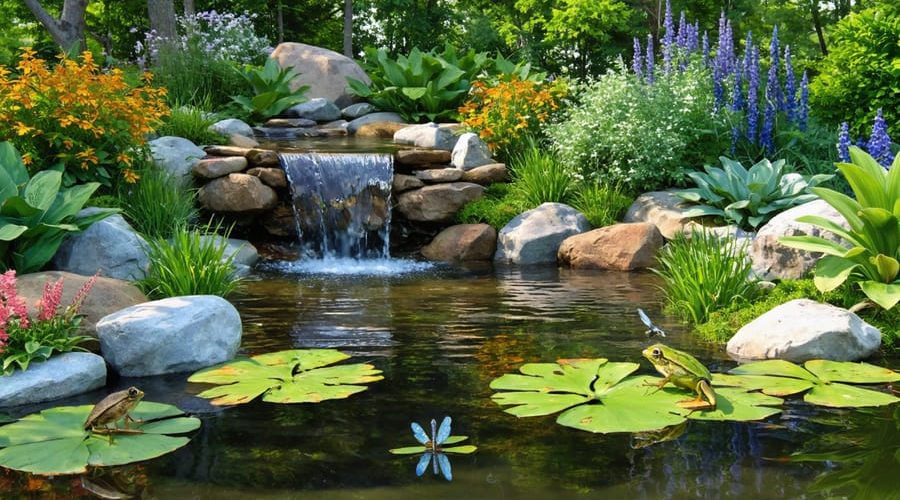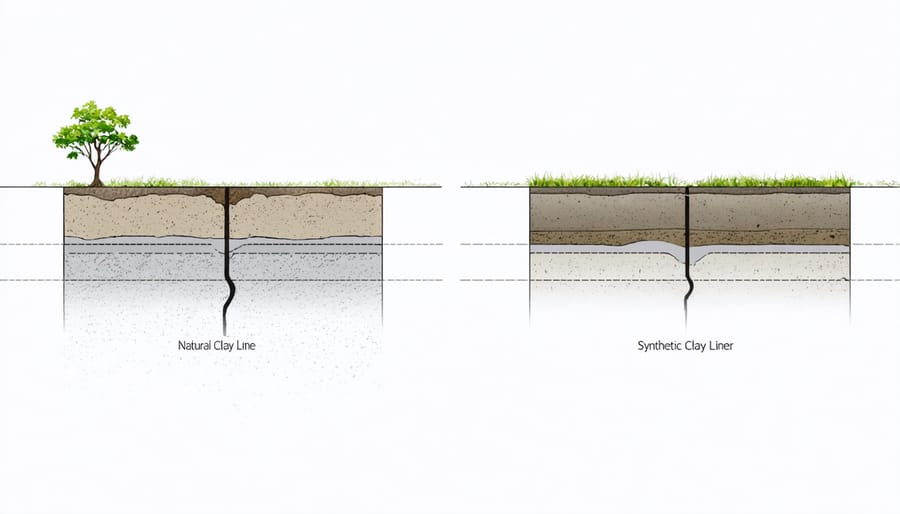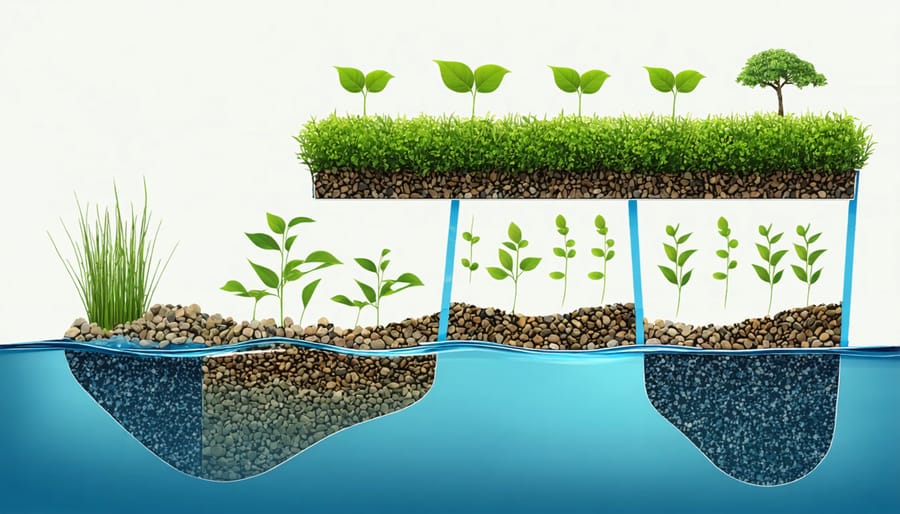
Build Your Dream Natural Pond Using Earth-Friendly Materials
Transform your backyard into a thriving ecosystem by building a natural pond that harmoniously blends with the surrounding landscape. Natural pond building goes beyond mere decoration – it creates a sustainable habitat that attracts wildlife, purifies water naturally, and requires minimal maintenance once established.
Unlike conventional pool construction, natural pond building embraces organic shapes, native plants, and chemical-free filtration systems. The process begins with careful site selection, considering natural water flow patterns and existing topography. Strategic placement of rocks, aquatic plants, and beneficial bacteria establishes a self-sustaining balance that mirrors nature’s own water features.
Whether you’re dreaming of a small wildlife pond or planning a larger swimming pond, the principles remain the same: work with nature, not against it. This comprehensive guide will walk you through the essential steps of creating your own natural pond, from initial planning and excavation to establishing a thriving aquatic ecosystem that will bring joy for years to come.
By following ecological design principles and using sustainable materials, you’ll create more than just a water feature – you’ll establish a living, breathing ecosystem that enhances your property’s biodiversity while providing a stunning focal point for your outdoor space.
Essential Natural Materials for Your Pond
Clay-Based Liners vs Synthetic Options
When it comes to lining your natural pond, you have two main options: clay-based liners and synthetic materials. Clay liners are the more environmentally friendly choice, as they’re completely natural and create a seamless connection with the surrounding ecosystem. Bentonite clay, in particular, is excellent for pond construction because it expands when wet, forming a watertight seal that can last for decades.
Natural clay liners support beneficial bacteria and microorganisms that help maintain healthy pond water. They also allow for better integration of aquatic plants, as roots can grip naturally into the clay substrate. Plus, clay-lined ponds tend to maintain more stable temperatures, which is great for fish and other aquatic life.
Synthetic liners, like EPDM rubber or PVC, offer perfect waterproofing and are easier to install. However, they create a barrier between the pond and the natural ground, potentially limiting biological processes. They also have a higher environmental impact during manufacturing and eventually need replacement, creating waste.
Cost-wise, clay liners can be more expensive initially, especially if you need to import high-quality bentonite. However, they typically last longer than synthetic options and require less maintenance over time. The choice often comes down to your specific site conditions – clay liners work best in areas with naturally clay-rich soil, while synthetic liners might be more practical in sandy or rocky locations.

Natural Stone Selection
Selecting the right stones for your natural pond is crucial for both aesthetics and functionality. Local stones are ideal as they blend seamlessly with your landscape and reduce transportation costs. Start by exploring nearby quarries or stone yards, looking for a mix of flat and rounded stones in varying sizes.
For pond edges, opt for larger, flat stones that extend at least 2-3 inches over the water. These overhanging edges provide shelter for wildlife and help conceal pond liner edges. Choose stones with natural weathering patterns – they’ll create a more authentic look and provide better grip when wet.
When selecting stones for features like waterfalls or cascades, look for pieces with natural depressions or channels that water can flow through. Weathered limestone, granite, and slate are excellent choices, as they’re durable and resist erosion. Avoid soft stones like sandstone, which can deteriorate quickly in water.
Consider creating different zones with your stone selection. Use smaller, rounded stones for shallow areas and beach entries, medium-sized rocks for plant shelves, and larger boulders for dramatic focal points. Remember to check that your chosen stones haven’t been treated with chemicals that could harm pond life.
Always test stones by soaking them in water for a few days before installation. This ensures they won’t affect water chemistry and reveals any potential issues with crumbling or discoloration.
Sustainable Edge Construction
Plant-Based Border Solutions
Creating stable, beautiful pond edges starts with choosing the right plants and natural materials. When planning your natural-looking pond design, incorporating native plants along the border serves multiple purposes: it prevents erosion, creates wildlife habitat, and helps your pond blend seamlessly into the landscape.
Start by selecting a mix of marginal plants, which grow in shallow water along the pond’s edge. Popular choices include rush, iris, and cattails, which develop strong root systems that hold soil in place. Behind these, plant moisture-loving perennials that thrive in damp conditions, creating a gradual transition from water to land.
For added stability, lay coconut fiber rolls (also called coir logs) along steeper sections of the pond edge. These biodegradable rolls provide immediate erosion control while giving plants time to establish. Secure them with wooden stakes and plant directly into them for a natural look.
Stone placement is another crucial element of border stabilization. Use a combination of different-sized rocks and pebbles to create a natural-looking edge. Place larger stones at the waterline, partially submerged, with smaller stones filling gaps between them. This not only looks authentic but also provides vital hiding spots for pond wildlife.
Remember to leave some areas with a gentler slope for wildlife access. These “beach” areas can be stabilized with a layer of gravel and small stones, creating safe entry and exit points for birds and beneficial insects.
For best results, install plants during spring or early summer, giving them plenty of time to establish before winter. Water new plantings regularly until their root systems develop, ensuring they can effectively hold the soil in place.
Eco-Friendly Shelving Systems
When creating shelves and depth variations in your natural pond, sustainable materials can provide both stability and environmental benefits. Start by using locally sourced rocks and stones of varying sizes to build natural ledges. Large, flat rocks work excellently for creating stable shelves, while smaller stones can fill gaps and provide additional support.
Consider incorporating fallen logs or reclaimed wood that’s been properly treated for aquatic use. These materials not only create natural-looking shelves but also provide valuable habitat for beneficial microorganisms and small aquatic creatures. Position them strategically to create different depth zones, ensuring they’re firmly anchored in the substrate.
For a truly eco-friendly approach, utilize excess soil from the pond excavation to create berms and shelves, reinforcing them with natural materials like coconut fiber rolls or jute matting. These biodegradable materials provide initial stability while plants establish their root systems, eventually breaking down to enrich the pond ecosystem.
When designing your shelves, aim for gradual transitions between depths. A good rule of thumb is to create three distinct zones: a shallow marsh area (2-8 inches deep), a marginal shelf (8-14 inches deep), and a deeper main pool (at least 2 feet deep). This variety of depths not only supports different types of aquatic plants but also helps maintain healthy water circulation and temperature regulation.
Remember to angle your shelves slightly inward toward the deeper areas to prevent soil erosion and maintain the structural integrity of your pond over time.


Natural Filtration Systems
Gravel and Stone Filters
Gravel and stone filters are the workhorses of natural pond filtration, creating essential biological cleaning zones that keep your water crystal clear. Start by creating a graduated filtration system using different sizes of stone and gravel, from larger rocks at the bottom to fine gravel at the top.
Begin with a layer of 2-3 inch rocks at the base, which provides spaces for beneficial bacteria to colonize. Add a middle layer of 1-inch river rock, perfect for both filtration and aesthetic appeal. Top it off with pea gravel or aquarium gravel, which helps trap smaller particles while allowing water to flow freely.
Position your filter zone at the pond’s edge where water naturally flows, or create a dedicated filter bed that water passes through before entering the main pond. Local quarries often offer suitable materials at better prices than garden centers, and using native stone helps your pond blend naturally with the surrounding landscape.
For enhanced filtration, consider creating a shallow gravel bed where marginal plants can root. These plants work together with the stone layers to remove excess nutrients and filter debris. Remember to occasionally clean your gravel filter by gently stirring the top layer and removing any accumulated muck – though don’t clean too thoroughly, as you want to preserve the beneficial bacteria that make your natural filter system work.
Aquatic Plant Filters
Aquatic plants are nature’s own water filtration system, and incorporating them into your pond creates a self-sustaining ecosystem. Native plants like cattails, rushes, and water irises work tirelessly to remove excess nutrients and filter out pollutants, keeping your pond water crystal clear naturally.
Create a dedicated plant filtration zone at the pond’s edge where water enters. This area, known as a bog garden, should be slightly shallower than the main pond and filled with gravel or pebbles. Plant your chosen filtering species densely in this zone, allowing their roots to form an intricate network that traps particles and absorbs nutrients.
Some excellent filtering plants include:
– Water Iris: Removes heavy metals and helps control algae
– Cattails: Excellent at removing nitrogen and phosphates
– Pickerelweed: Absorbs excess nutrients while providing beautiful purple blooms
– Rush: Dense root systems trap sediment and filter water
– Water Mint: Adds fragrance while helping purify water
Position these plants so water must flow through their root systems before entering the main pond. For best results, aim to cover about 30% of your pond’s surface with plants. This balance provides optimal filtration while maintaining open water for fish and wildlife.
Remember to trim back plants periodically and remove dead foliage to prevent decomposing material from releasing nutrients back into the water. This natural filtration system improves with time as plants establish themselves and their root systems develop.
Maintenance and Long-Term Sustainability
A natural pond requires regular attention to maintain its delicate ecosystem while staying true to sustainable principles. The key to maintaining your pond is finding the right balance between intervention and letting nature take its course.
Start by monitoring water quality monthly, checking pH levels and watching for any unusual algae growth. Rather than reaching for chemical solutions, consider adding more oxygenating plants if you notice water quality issues. Native aquatic plants not only help maintain water clarity but also provide natural filtration and habitat for beneficial organisms.
Remove fallen leaves and debris regularly, especially during autumn, to prevent excess organic matter from decomposing in the water. A simple pond net works wonders and the collected material makes excellent compost for your garden. Trim back marginal plants annually to prevent overgrowth and maintain healthy water flow.
Pay attention to water levels, particularly during dry spells. Consider installing a rain barrel system to capture rainwater for topping up your pond sustainably. If you have a pump or filter system, clean it seasonally using collected rainwater rather than tap water to preserve the pond’s natural balance.
Watch for signs of wildlife activity and adjust maintenance accordingly. If you notice frogs spawning or dragonflies laying eggs, reduce disturbance in these areas temporarily. Creating wildlife-friendly zones helps maintain a self-sustaining ecosystem.
During winter, avoid breaking ice that forms on the surface – this can shock pond inhabitants. Instead, float a ball on the surface to keep a small area ice-free for gas exchange. If you have fish, reduce feeding as temperatures drop and remove dead plant material before winter sets in.
Long-term sustainability means thinking ahead. Plant native species that will naturally propagate, creating a self-maintaining environment. Consider adding a bog filter area with specific plants that excel at natural filtration, reducing the need for mechanical intervention. Remember, a truly natural pond becomes more stable and self-sufficient over time, requiring less maintenance as its ecosystem matures.
Building a natural pond is more than just creating a water feature – it’s about crafting a sustainable ecosystem that benefits both you and the environment. Throughout this guide, we’ve explored how to choose the perfect location, select natural materials, and incorporate native plants and wildlife-friendly elements into your pond design.
Remember that successful natural pond building relies on patience and careful planning. By following the core principles we’ve discussed – using liner-free construction where possible, incorporating plenty of plant life, and maintaining proper water circulation – you’ll create a thriving aquatic habitat that requires minimal maintenance.
The key to long-term success lies in working with nature rather than against it. Choose local materials when possible, plant native species, and allow your pond to develop its natural balance over time. While it might take a few seasons for your pond to fully mature, the reward of watching frogs, dragonflies, and birds make their home in your creation is well worth the wait.
As you embark on your pond-building journey, keep sustainability at the forefront of your decisions. Consider rainwater collection systems, solar-powered pumps, and natural filtration methods to minimize your environmental impact. With proper planning and care, your natural pond will become a beautiful, self-sustaining feature that enhances your outdoor space and supports local biodiversity for years to come.
